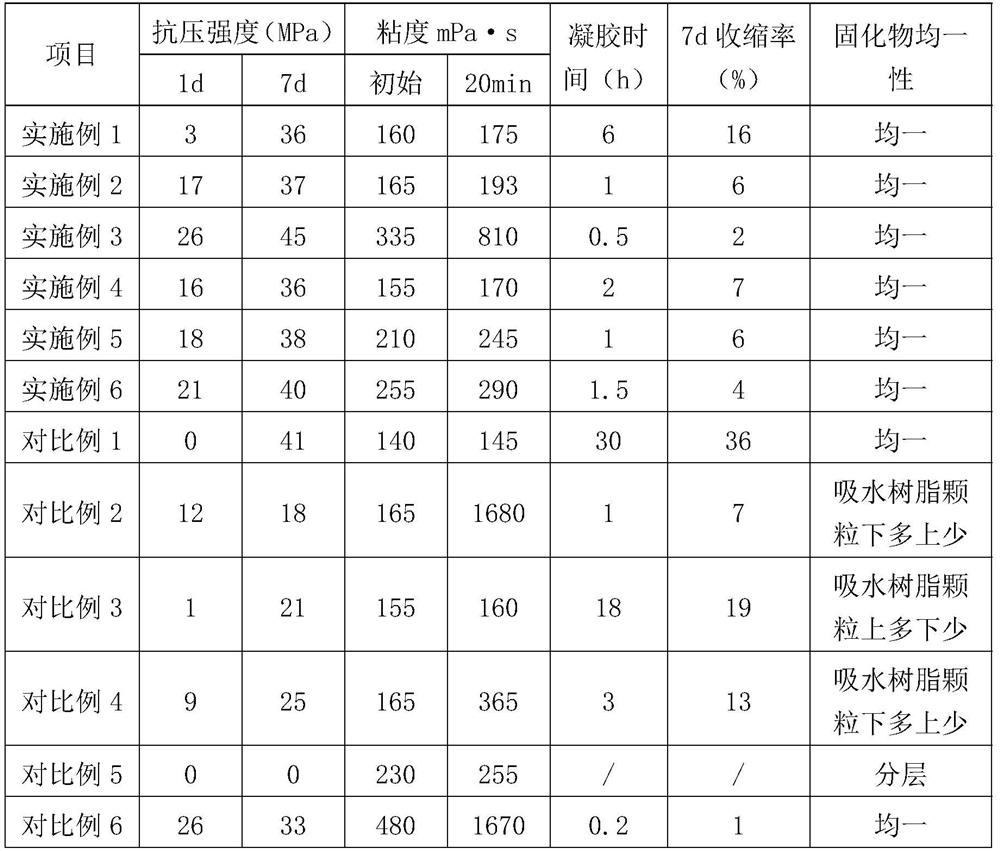Water-borne epoxy resin and preparation method thereof
A water-based epoxy resin and epoxy resin technology, applied in the field of polymer materials, can solve the problems of difficult drying of the coating film, difficulty in evaporating water, and low evaporation rate
- Summary
- Abstract
- Description
- Claims
- Application Information
AI Technical Summary
Problems solved by technology
Method used
Image
Examples
Embodiment 1
[0038] S1: Weigh 90 parts of lauric acid and 10 parts of polyethylene glycol ether, mix evenly, stir at 70°C until melting, and obtain the shell material;
[0039] S2: Weighing 20 parts of starch-grafted acrylate water-absorbing resin, adding to 80 parts of the shell material prepared in S1 and stirring evenly, after spraying and condensing, an encapsulated water-absorbing resin is obtained;
[0040] S3: Weigh 30 parts of bisphenol A type epoxy resin E51, 1 part of encapsulated water-absorbing resin, 20 parts of polyethylene glycol modified fatty amine and 49 parts of water, and first mix the bisphenol A type epoxy resin E51. Polyethylene glycol-modified fatty amine is mixed and pre-reacted for 1 min, then added with water and stirred until homogeneously emulsified, then added with encapsulated water-absorbing resin and stirred evenly to obtain a water-based epoxy resin emulsion.
Embodiment 2
[0042] S1: Weigh 70 parts of lauric acid and 30 parts of polyethylene glycol ether, mix evenly, stir at 70°C until melting, and obtain the shell material;
[0043] S2: Weighing 20 parts of starch-grafted acrylate water-absorbing resin, adding to 80 parts of the shell material prepared in S1 and stirring evenly, after spraying and condensing, an encapsulated water-absorbing resin is obtained;
[0044] S3: Weigh 30 parts of bisphenol A epoxy resin E51, 5 parts of encapsulated water-absorbing resin, 20 parts of carboxyl-terminated polyether modified fatty amine and 45 parts of water, and first mix bisphenol A epoxy resin E51. Carboxyl-terminated polyether-modified fatty amine is mixed and pre-reacted for 1 min, then added with water and stirred until homogeneously emulsified, then added with encapsulated water-absorbing resin and stirred evenly to obtain a water-based epoxy resin emulsion.
Embodiment 3
[0046] S1: Weigh 80 parts of lauric acid and 20 parts of polyethylene glycol ether, mix evenly, stir at 70°C until melting, and obtain the shell material;
[0047] S2: Weighing 20 parts of starch-grafted polyacrylamide water-absorbing resin, adding to 80 parts of the shell material prepared in S1 and stirring evenly, after spraying and condensing, an encapsulated water-absorbing resin is obtained;
[0048] S3: Weigh 35 parts of bisphenol A epoxy resin E51, 5 parts of neopentyl glycol diglycidyl ether, 5 parts of phenyl glycidyl ether, 5 parts of encapsulated water-absorbing resin, and 30 parts of carboxyl-terminated polyether Modified fatty amine and 20 parts of water, first mix bisphenol A epoxy resin E51, neopentyl glycol diglycidyl ether, phenyl glycidyl ether, carboxyl-terminated polyether modified fatty amine for 1 min, add water Stir until it is homogeneously emulsified, then add the encapsulated water-absorbing resin and stir evenly to obtain a water-based epoxy resin emu...
PUM
 Login to View More
Login to View More Abstract
Description
Claims
Application Information
 Login to View More
Login to View More - R&D
- Intellectual Property
- Life Sciences
- Materials
- Tech Scout
- Unparalleled Data Quality
- Higher Quality Content
- 60% Fewer Hallucinations
Browse by: Latest US Patents, China's latest patents, Technical Efficacy Thesaurus, Application Domain, Technology Topic, Popular Technical Reports.
© 2025 PatSnap. All rights reserved.Legal|Privacy policy|Modern Slavery Act Transparency Statement|Sitemap|About US| Contact US: help@patsnap.com

